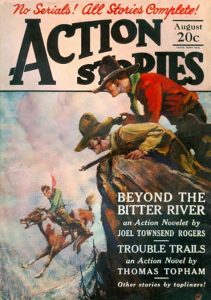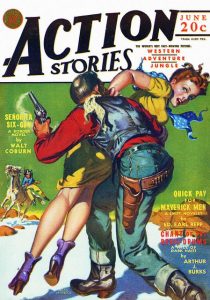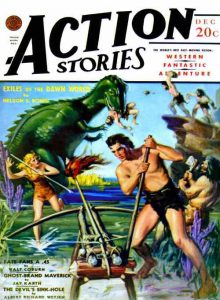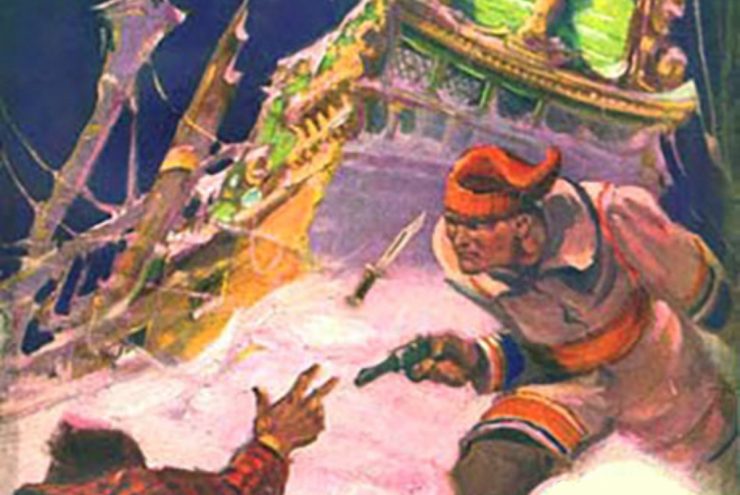Pulp magazines have influenced writers, artists, film directors, software developers, and countless others over the years. Our “Pulp History” articles focus on the rough-paper writers, editors, publishers, and artists who have inspired and continue to inspire the creators of the world’s popular culture.
 In the spring of 1921, a couple of Irish lads who sold magazines got together to found Fiction House.
In the spring of 1921, a couple of Irish lads who sold magazines got together to found Fiction House.
John W. Glenister was born in New York City in 1874. He started selling papers at the age of nine. Five years later, he hitched a ride on a Chicago-bound freight train. He later told Brooklyn’s SUNDAY EAGLE MAGAZINE, “There’s nothing unusual in that, you know. All young boys thirst for adventure,” he said.
In the late 1890s, Glenister became a professional swimmer. After swimming the English Channel in 1897, he gained international notoriety as the first man to cross the Whirlpool Rapids of the Niagara River. Crediting his feat to Lady Luck, Glenister quipped, “You must realize that it wasn’t really swimming, but merely keeping above water and keeping my lungs full of air. The currents swirled me over to the other side.”
“Bearcat” Glenister — as he was called — found himself a celebrity. He was soon endorsing products and speaking on the vaudeville circuit. Before long, he was producing plays and working in circulation for Boston and New York City newspapers. When he teamed up with John B. “Jack” Kelly, Glenister was the circulation manager for Warner Publications, promoting CLEVER STORIES, FASCINATING FICTION, FIELD AND STREAM, THE PARISIENNE, SAUCY STORIES, and THE SMART SET.
 Like Glenister, Jack Kelly was born in New York City. Growing up in Brooklyn, Kelly entered the workforce following the death of his father in 1896. Starting as a copy boy for a Brooklyn newspaper at the age of ten, Jack rose through the ranks of publishing. In addition to newspapers, he worked for THE AMERICAN MAGAZINE and EVERYBODY’S. By 1914, he was the circulation manager for METROPOLITAN MAGAZINE, where former US President Theodore Roosevelt served as editor. Kelly left the magazine when he and John Glenister became business partners.
Like Glenister, Jack Kelly was born in New York City. Growing up in Brooklyn, Kelly entered the workforce following the death of his father in 1896. Starting as a copy boy for a Brooklyn newspaper at the age of ten, Jack rose through the ranks of publishing. In addition to newspapers, he worked for THE AMERICAN MAGAZINE and EVERYBODY’S. By 1914, he was the circulation manager for METROPOLITAN MAGAZINE, where former US President Theodore Roosevelt served as editor. Kelly left the magazine when he and John Glenister became business partners.
Fiction House was incorporated by Jack Kelly and J. W. Glenister on April 14, 1921. Its first magazine, ACTION STORIES, was an adventure pulp. Debuting with its September 1921 number, ACTION STORIES offered a variety of fiction, including adventure, aviation, detective, mystery, sea, sports, and — most of all — western stories. As J. W. Glenister told the SUNDAY EAGLE:
In my investigations, I have found that many of the biggest men in the country read wild west and outdoor magazines. I think it is because high-powered brains need relaxation in idle reading moments.
 In an undated interview with Ray Humphreys of THE DENVER POST, Jack Kelly remarked:
In an undated interview with Ray Humphreys of THE DENVER POST, Jack Kelly remarked:
. . . in the minds of millions of readers of the popular magazines, it spells adventure, the tang of the sagebrush, the crisp Alpine breeze, the old prospector, the swaggering cow waddy, the Indian, and the two-gun man. They want the thrill, the action, the aggressiveness of the west . . . and the magazines are profiting by it. Four million American boys took part in the war . . . they got out of the offices, away from the mills, out from behind the counters, and saw real life. When the war was over and they went back to the commonplace things, they still craved adventure. The magazines supplied it.
Within a few years of its debut, ACTION STORIES was selling 150,000 copies of each issue. Fiction House decided to expand its line of magazines, first with NOVELETS and later, TRUE ADVENTURES. Many more would follow, including a line of comic books.
Thirty years after ACTION STORIES was launched, Jack Byrne — then the managing editor for Fiction House — wrote:
Sometimes I think I learned what I know about the pulps from Kelly and Glenister back in wonderful 1925 and that the curves and twists of the years have only refined the truths I couldn’t digest at the time.
Kelly and Jack Glenister, the founders of Fiction House, were brisk young circulation men. They came into the pulps in the early 20s, along with Bill Clayton and George Delacorte. Kelly’s theories about his publications scramble up to something like this:
Pulp-paper stories should be based on action because action is easy to understand and easy to write.
 Through ACTION STORIES, LARIAT STORY MAGAZINE, WINGS, NORTH-WEST STORIES, FRONTIER STORIES, LOVE ROMANCES, PLANET STORIES, JUNGLE STORIES, FIGHT STORIES, and countless other titles, Fiction House delivered what readers wanted — action, adventure, romance, and more — all for a couple of dimes.
Through ACTION STORIES, LARIAT STORY MAGAZINE, WINGS, NORTH-WEST STORIES, FRONTIER STORIES, LOVE ROMANCES, PLANET STORIES, JUNGLE STORIES, FIGHT STORIES, and countless other titles, Fiction House delivered what readers wanted — action, adventure, romance, and more — all for a couple of dimes.
Although Jack Kelly passed away in 1932 and J. W. Glenister in 1937, the publisher labored on for nearly two decades more. Fiction House closed up shop in 1955, succumbing to declining readership and the growing popularity of paperbacks and television.
We’ll be saluting Fiction House and more at PulpFest 50. We hope you’ll join us August 4 – 7 in 2022 for “Action for a Dime.” Only at the DoubleTree by Hilton Hotel Pittsburgh – Cranberry in Mars, Pennsylvania.
Freelance artist Henry C. Murphy, Jr. was the “go-to” artist for ACTION STORIES from late 1925 until the fall of 1930. Leading our post is Murphy’s cover painting for the August 1926 number, followed by his work for the December 1925 number. Allen Anderson would be one of the magazine’s leading cover artists during the 1940s. You’ll find his “good girl” cover art for the June 1942 issue pictured above.
Although largely delegated to PLANET STORIES (which debuted at the end of 1939), Fiction House occasionally ran science fiction in ACTION STORIES. Pictured here is the December 1940 issue — with cover art by George Rozen, illustrating Nelson Bond’s novella, “Exiles of the Dawn World.”
David Saunders’ biographies of John W. Glenister and John B. “Jack” Kelly from his Field Guide to Wild American Pulp Artists proved invaluable in the writing of this post. Glenister’s quotes from the SUNDAY EAGLE MAGAZINE are from October 18, 1925. The Jack Bryne quote is from the WRITER’S 1951 YEAR BOOK, reprinted in PULP FICTIONEERS: ADVENTURES IN THE STORY TELLING BUSINESS, edited by John Locke. Ray Humphrey’s interview with Jack Kelly is from the Facebook page of The Pulp Magazines Project.







